Ice Fishing Experiment for Kids
The kids are going to love this Ice Fishing Experiment for Kids. This is a fun way for them to be hands-on while they’re learning as well!
Need more winter ideas? See this list of fun winter activities for kids.
If you’re looking for fun new activities to teach the kids and keep them busy this summer, this is the one for you. Not only it is nice and “cool”, but it’s just really easy as well. The kids will think that it’s unique and fun, which will just add to their excitement.
And the good news? All you need are just a few simple supplies to get started. You can easily create this fun fishing experiment in just a few moments at home.
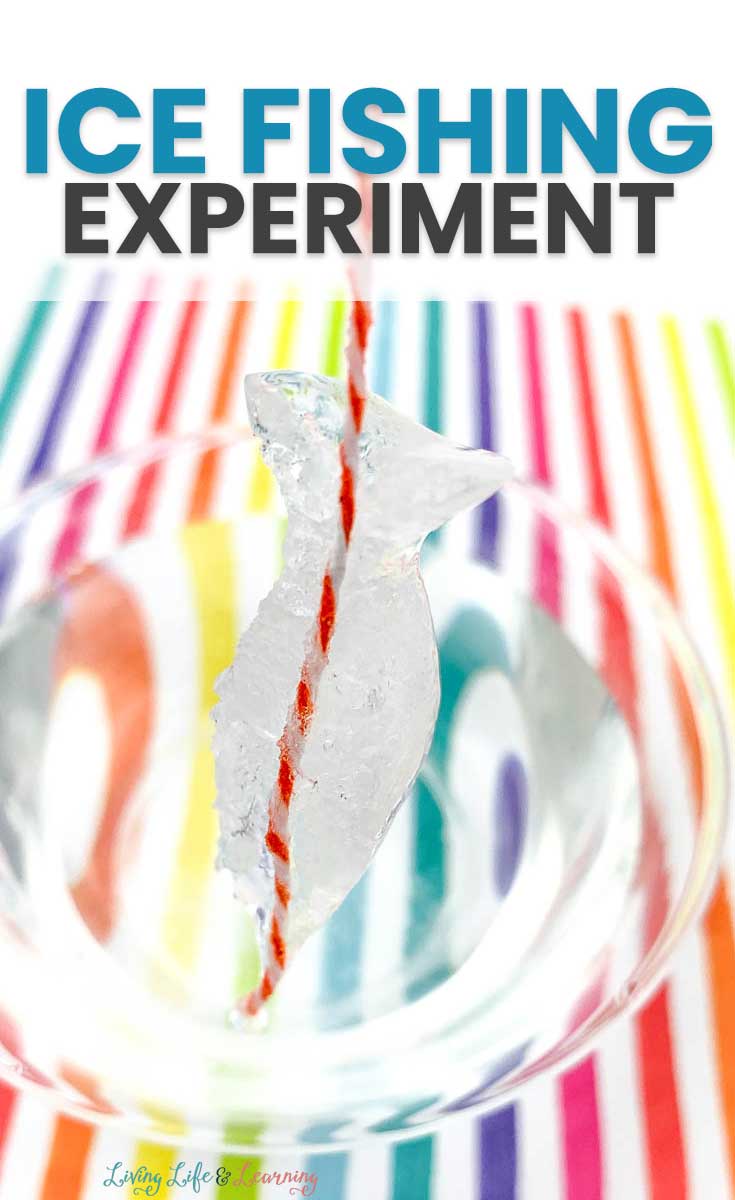
Make certain to check out the rest of our simple homeschool science experiments for kids as well. It’s always a good time to keep learning!
This post may contain affiliate links meaning I get commissions for purchases made through links in this post. Read my disclosure policy here.
Ice Fishing Experiment for Kids
I was instantly drawn to this simple science experiment because it involves fishing. Fishing is one of those activities that everyone just tends to like. I’m not saying I like to take a real fish off the fishing line…but I do appreciate a good fishing day out in nature, sitting on the dock patiently waiting.
There’s just something calming and exciting about the thought of fishing so I was excited to bring up this similar science activity for the kids to do.
But since we aren’t able to get out and get fishing, I thought that it’d be fun to bring that activity in the house to the kids. It’s a tad bit different and it uses science as learning fun!
Best Science Books for Kids
Don’t forget about books. The power of reading just can’t be topped. If you’re looking for a simple way to supplement with even more learning, science books are a great way to make that happen.
If I could spend all our money on books, I just might be tempted to do that. I love having books in the house for the kids to grab. The more that they can read, the more that they’re working their brain. And the more that they’re working their brain, the more that they’re learning.
Weekly trips to the library and book shopping lists are what our summers and weeks tend to consist of. I’ll happily buy my kids a book when they want it any day rather than have them staring at screens.
As you can tell from the book recommendations below, you’re going to have a ton of other fun science activities for the kids. They’ll love learning and using their hands to create some truly scientific activities.
Here are some of our favorite science books for kids that I think you’re going to like as well.
Recommended Science Experiment Books
Looking to add more ‘wow’ to your science explorations? Well, look no further! I’ve handpicked a whole library of the most amazing Science Experiment Books that are perfect for inquisitive kiddos like yours!
Awesome Science Experiments for Kids: 100+ Fun STEM / STEAM Projects and Why They Work (Awesome STEAM Activities for Kids)The Everything Kids’ Science Experiments Book: Boil Ice, Float Water, Measure Gravity-Challenge the World Around You!Awesome Kitchen Science Experiments for Kids: 50 STEAM Projects You Can Eat! (Awesome STEAM Activities for Kids)Awesome Outdoor Science Experiments for Kids: 50+ STEAM Projects and Why They Work (Awesome STEAM Activities for Kids)Steve Spangler’s Super-Cool Science Experiments for Kids: 50 mind-blowing STEM projects you can do at homeSmithsonian 10-Minute Science Experiments: 50+ quick, easy and awesome projects for kids
Supplies Needed for This Ice Fishing Experiment for Kids
Just gather up the list of supplies to get started. As you can tell, you probably already have these sitting around the house!
- Fish ice cube tray
- Water
- Blue food coloring (optional)
- Salt
- Straw (for stirring)
- Stick (for fishing pole)
- String (cut about 12in. long)
- Marbles (optional)
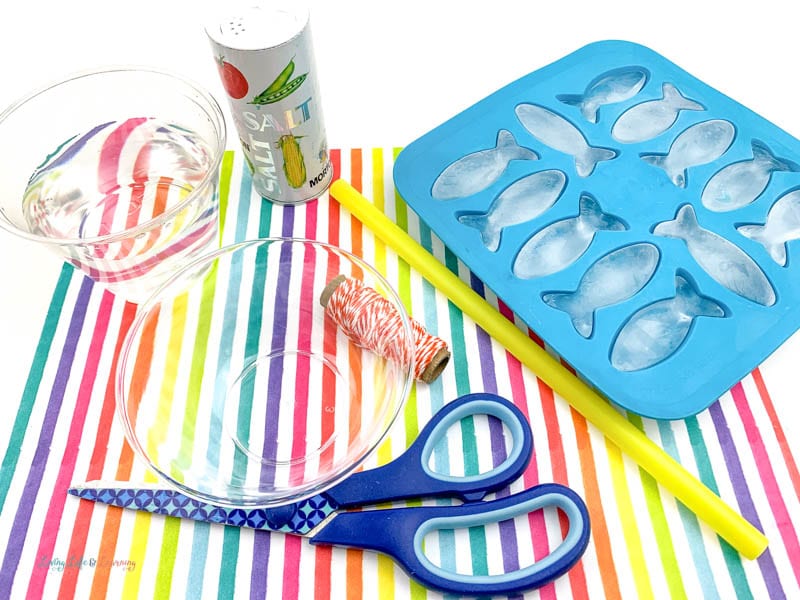
This science activity isn’t hard to do at all but it does require the kids to follow a few simple steps.
You can add a few drops of blue coloring to the water, if you want, to give it more of that “water” look. I didn’t but that’s just because I didn’t feel like it and honestly probably didn’t have any blue food coloring on hand when I started this experiment.
You’ll have to fill the tray with water and then put it into the freezer to freeze overnight.
You can make your own fishing pole by just attaching string to a pole.
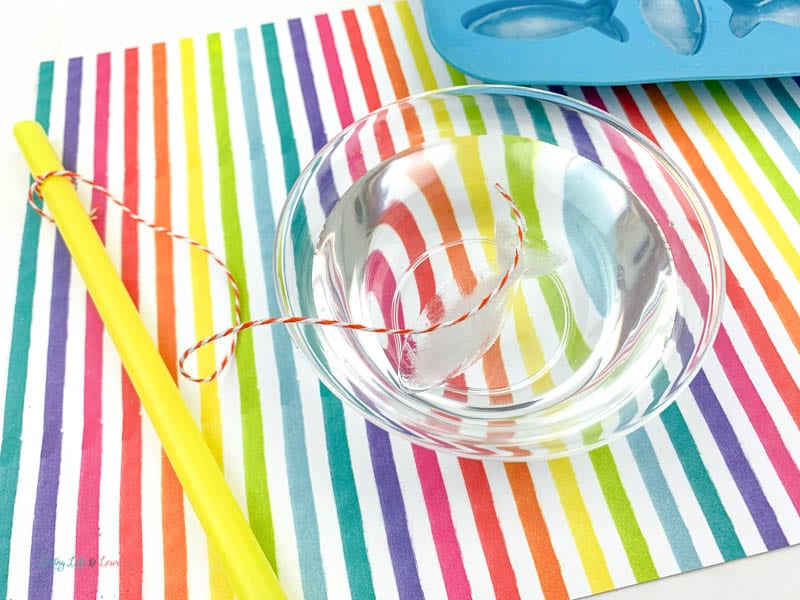
Once the fish cube has been formed overnight, it’s time to see if it can be caught. Place one fish cube into the water and have your child try to catch it with the strong.
Will it work? More than likely not.
But…if you shake a bit of salt on the string as it’s on top of the ice fish and give it a few seconds, magic will happen and the fish will get caught!
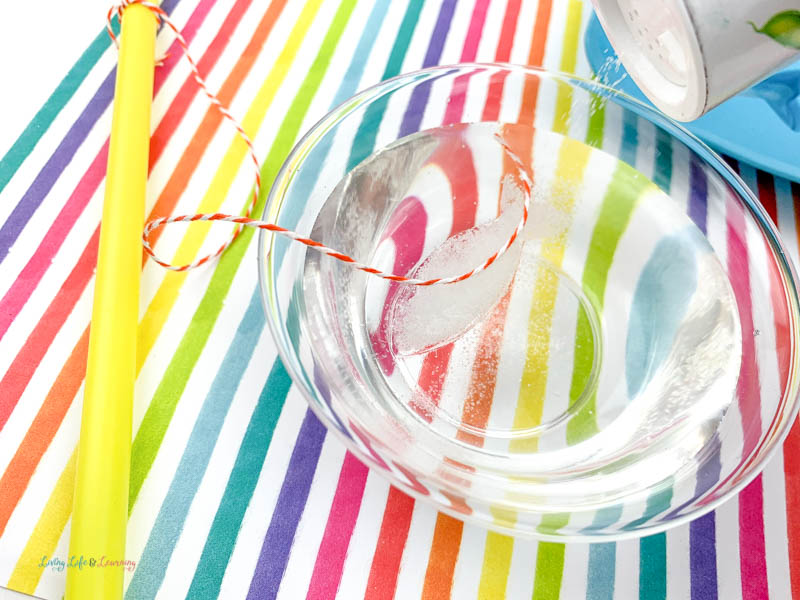
Your child may have to be a bit patient with this activity as it can take longer for the water and ice to melt enough to stick. You’re basically using the salt to melt the ice enough so that it then allows the string to stick on it.
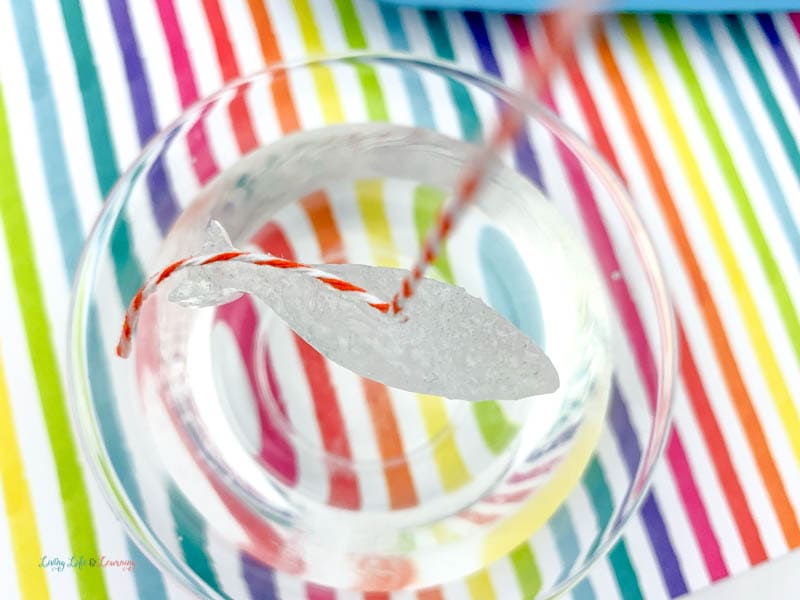
Tips for this Ice Fishing Experiment
There are a few things that are really important for this experiment to work. First, the ice has to be solid and formed. You can’t rush this. Just plan for that time and make it happen.
Next, the ice cube has to be in the water for this to work. Don’t try to do this without a bowl of water – it’s not going to work.
Lastly, you’re going to have to be patient when figuring out the right amount of salt. It might take a few shakes or a little more to make it work. Don’t give up!
Talking to your kids about this experiment
Make certain to have conversations with your kids during this experiment. Find out what they think, what they think is going to happen, and what their predictions are. They’ll be able to say what they think is going to happen and then see if they’re right!
Have so much fun with this easy and fun science experiment. The kids are going to think that it’s a blast! Have them try out different methods and what they think will happen versus what really does happen. This is the best way to have them think with a scientific brain to find out what is true or not! They’re going to have so much fun with this!
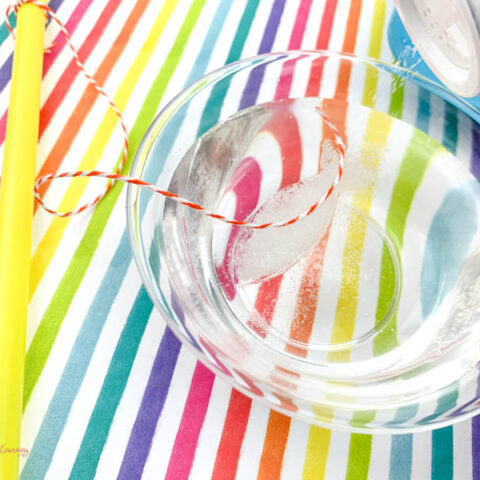
Ice Fishing Experiment for Kids
This is such a fun simple science experiment!
Materials
- Silicone fish tray
- Water
- Blue food coloring (optional)
- Salt
- Straw (for stirring)
- Stick for pole
- String (cut about 12in. long)
- marbles (optional)
Instructions
Add food coloring to the water. Optional.
Fill the tray and put in the freezer overnight.
Tie the string to the top of the stick.
Pour water in a bowl. Take the frozen fish ice out of the tray and put it into the bowl.
Let the child try to put the line on the fish.
Shake a tad bit of salt over the string and wait a few seconds. The salt will help the fish get caught!
.
Recommended Products
As an Amazon Associate and member of other affiliate programs, I earn from qualifying purchases.
More Science Fun
Don’t stop with this fun science experiment. Make certain to check out these other fun activities!
Simple Dissolving Peeps Science Experiment
Edible Kitchen Science Experiments
Fun Winter Science Experiments









